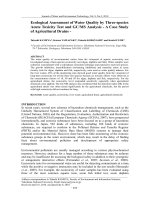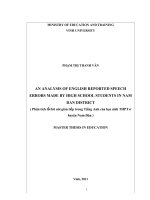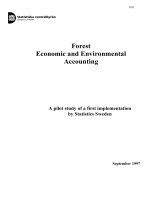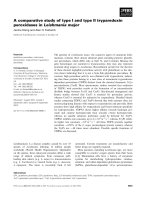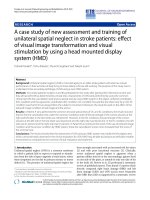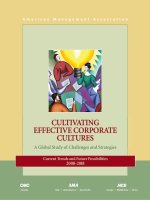A Phenomenological study of challenges encountered by mountainous high school students in Vietnam
Bạn đang xem bản rút gọn của tài liệu. Xem và tải ngay bản đầy đủ của tài liệu tại đây (2.41 MB, 8 trang )
<span class='text_page_counter'>(1)</span><div class='page_container' data-page=1>
<i>DOI: 10.22144/ctu.jen.2017.020 </i>
<b>A Phenomenological study of challenges encountered by mountainous high school </b>
<b>students in Vietnam </b>
Le Thi Hong Cam, Phuong Hoang Yen
<i>School of Foreign Languages, Can Tho University, Vietnam </i>
<b>Article info. </b> <b> ABSTRACT </b>
<i>Received 04 Jun 2016 </i>
<i>Revised 19 Jul 2016 </i>
<i>Accepted 29 Jul 2017</i>
<i><b> English writing skills have received considerable attention from Vietnam </b></i>
<i>Ministry of Education and Training with their decision involved the skills </i>
<i>in the national examination for General Certificate of Secondary </i>
<i>Educa-tion (GCSE) for the past two years. However, that many high school </i>
<i>stu-dents in mountainous areas in Vietnam are encountering challenges of </i>
<i>writing in English results in their low marks in writing tests, or even their </i>
<i>avoidance of writing assignments. With such a phenomenon, this paper is </i>
<i>aimed at investigating challenges that high school students in </i>
<i>mountain-ous areas encounter in English writing. The 5-point Likert scale </i>
<i>ques-tionnaires were delivered to 520 grade-12 students from three high </i>
<i>schools in mountainous areas, Vietnam. The results revealed that high </i>
<i>school students in mountainous areas encountered many challenges </i>
<i>relat-ed to English writing. It obviously provrelat-ed that poor spelling, inadequate </i>
<i>mastery of grammatical structures, the first language interference, lack of </i>
<i>vocabulary, and poor understanding of a well-organized presentation are </i>
<i>the most common challenges. The findings will be the first step to assist </i>
<i>high school teachers to achieve in-depth understanding of students’ </i>
<i>chal-lenges in English writing as well as to prepare for the textbook changes in </i>
<i>Vietnam in 2018. </i>
<i><b>Keywords </b></i>
<i>Challenges in English </i>
<i>writ-ing, high school students, </i>
<i><b>mountainous areas </b></i>
Cited as: Cam, L.T.H., Yen, P.H., 2017. A Phenomenological study of challenges encountered by
<i>mountainous high school students in Vietnam. Can Tho University Journal of Science. Vol 6: 1-8. </i>
<b>1 INTRODUCTION </b>
“Writing is a way of life. Without some ability of
expressing oneself in writing, a person does not
pass the course” (Brown, 2000, p.339). Moreover,
it is said that writing is a two-step process. First,
learners figure out their meaning, then they put it
into language. Meaning is not what learners start
out with, but what learners end up with (Peter
El-bow, 1973, cited in Brown, 2000). Therefore, most
of the students who do not perform well in English
writing tasks ultimately face average or poor
<i>re-sults in academics (Bilal et al., 2013). In addition, </i>
writing is a skill that second language learners take
time to acquire because it is not the way to write
down spoken language. To create a well-written
</div>
<span class='text_page_counter'>(2)</span><div class='page_container' data-page=2>
Regarding to teaching and learning English in
Vi-etnam, although writing has been taught as an
in-dependent skill in textbooks at upper secondary
schools for many years, it has just been included in
the national examination for General Certificate of
Secondary Education (GCSE) since 2014. This
results in students’ not keeping face with changes
in exams as well as their inability to generate a
well-written product. In fact, it is an undeniable
fact that most students’s writing skills are poor, or
even they are afraid of learning writing lessons as
well as practicing writing. Consequently, learners’
writing test results at high schools show to be far
from the requirement. Besides, looking at the
re-sults of the last two - year writing tests, it is
appar-ent that studappar-ents failed in generating a well-written
work. The low result of the GCSE examination in
the 2014-2015 school year was recorded with only
approximately 17.2% of students gaining
above-average marks (Tran Quoc Em, 2015). Moreover,
in the first semester of the 2015-2016 school year,
it was found that over one third of the high school
students in a mountainous town omitted the writing
assignment in their first – semester test. This
strongly encouraged this research to be conducted.
<b>2 LITERATURE REVIEW </b>
<b>2.1 Definition of writing </b>
<i>McDonough et al. (2013, p.189) defined writing as </i>
<i>“a process of encoding (putting your message into </i>
<i>words) carried out with a reader in mind”. </i>
Mean-while Bell and Burnaby (1984) took the view that
writing is an extremely complex cognitive activity
in which the writer is required to control a number
of variables simultaneously, which means that the
writer must plan the content, format, sentence
structure, vocabulary, punctuation, spelling and
idea formation (cited in Akinwamide, 2012).
Be-sides, it is well-documented that writing “focuses
students on how to generate ideas, how to organize
them coherently, how to use discourse markers and
rhetorical conventions to put them cohesively into
a written text, how to revise text for clearer
mean-ing, how to edit text for appropriate grammar, and
how to produce a final product” (Brown, 2000,
p.335). Ruddell (2005) described that in the
sec-ondary school, writing is considered as a stylized
task with assigned topics so that students can write
and submit for teachers to give marks. In addition,
Richards (2004) stated that writing is considered as
a constructed product which meets the writer’s
command of grammatical and lexical knowledge.
Therefore, to create a well-written product in the
second language, learners need not only to gain
good linguistic knowledge but also to know how to
gather, analyze, organize and present ideas and
information (Williams, 2005).
<b>2.2 The importance of writing in English </b>
To start with, Carter and Nunan (2001) presented
that the importance of second language writing has
been highlighted during the last decade. Examples
mentioned for this are (1) direct tests of writing
included in standardized tests of English language
proficiency such as Test of English as a Foreign
Language (TOEFL) of written English and British
Council’s IELTS (International English Language
Testing System) writing sub-test; (2) more courses
or at least coursework in graduate TESOL
(Teach-ers of English to Speak(Teach-ers to Other Languages)
programs for better teacher preparation for second
language instruction; and (3) a dramatic increase in
textbooks, and public research and commentary
about English second language writing. As a result,
lack of second language writing proficiency can
prevent people from academic and professional
success. Especially, learners will encounter
diffi-culty in getting through high school without
writ-ing (Williams, 2005).
With regard to students’ benefits relevant to
writ-ing skills, Nguyen (2015) stated that students can
benefit from being good at writing. Firstly, writing
helps students increase the ability of using
lan-guage, especially the ability of developing
vocabu-lary and grammar of the target language. Secondly,
writing can support other skills such as reading,
and speaking. Finally, writing is an approach to
access modern information technology and human
knowledge. In addition, Yingjie (2015) said that
two important goals of EFL (English as a Foreign
Language) writing are second language acquisition
and writing skill practice. Language learners use
the writing system to practice new language
knowledge, as well as to demonstrate their
knowledge in the context of assessment (Tribble,
<i>1996, cited in McDonough et al., 2013). </i>
Obvious-ly, writing encourages thinking and learning,
moti-vates communication, and makes thought available
<i>for reflection (Mekheimer, 2005, cited in Shafiee et </i>
<i>al., 2015). </i>
</div>
<span class='text_page_counter'>(3)</span><div class='page_container' data-page=3>
and revising procedures by specialized skills
(Brown, 2000). Furthermore, writing helps students
better comprehend, think critically, and construct
new understandings about what they are learning
(Emig, 1977; Rivard, 1994; Klein, 2000; cited in
<i>Gillespie et al., 2014). </i>
In terms of the importance of writing English
lan-guage for personal development and academic
suc-cess, Nyasimi (2015) noted that writing is
consid-ered the most vital language skill students need to
master. Besides, he also presented that writing
skills are of major importance to students at all
levels of education system in order to finish given
assignments at school as well as pass all
examina-tions. Furthermore, Nguyen (2015) asserted that
writing is the key to success in college and
univer-sity, which means that writing is a required skill in
all exams for foreign language certificates in order
to fulfill the required graduation qualification of
college and university. Due to its importance,
writ-ing in the second language should not be
under-looked.
<b>2.3 Challenges in writing English as a second </b>
<b>language </b>
Writing in the second language is a complex task
which causes the biggest challenge for many
stu-dents (Adas and Bakir, 2013; Dwivedi and
Chakraverthy, 2015; Phuket and Othman, 2015;
Rass, 2015) because writers must consider different
issues in their writing including content,
organiza-tion, purpose, audience, vocabulary and mechanics
including using the right punctuation, spelling and
capitalization. Writing in a second language is even
more demanding because it is “a complex,
chal-lenging, and difficult process” (Alsamadani, 2010,
cited in Rass, 2015, p.49).
Firstly, with challenges related to teachers, it is
presented that “a good teacher teaches, a better
teacher explains, and the best teacher inspires”
(Adas and Bakir, 2013, p.254). Teaching methods
and textbooks are considered as primary factors in
learners’ success (Brown, 2000). Therefore,
writ-ing lessons included in all upper secondary school
English textbooks imply that writing should be
taught as an independent skill; however, students
<i>seem to be below the required level (Ferede et al., </i>
2012). Noe (2004) took the view that perception
has a relationship to our actions and practices
<i>(cit-ed in Fer(cit-ede et al., 2012). Once both teachers and </i>
learners fail to consider writing important, their
perceptions can influence their teaching and
learn-ing of this skill. Then, writlearn-ing can be considered as
a difficult task. This deeply affects the students’
writing performance. It was illustrated by
Al.gomoul (2011) that methods of teaching English
writing and teaching aids contribute to challenges
<i>in students’ English writing. Moreover, Farooq et </i>
<i>al. (2012) claimed that teachers’ selecting a wrong </i>
pedagogic approach will lead students to face
chal-lenges in writing English language. Therefore,
teacher’s appropriate teaching method, useful
teaching aids, and teacher’s support and motivation
play a crucial role in assisting students partly avoid
challenges in writing in English.
In addition to challenges related to teachers, most
EFL students tend to encounter challenges by
themselves in writing in the second language, i.e.
affective, linguistic, and cognitive factors. In fact,
there is no doubt that these factors not only affect
learners’ writing performance, but also prevent
academic success. In terms of affective factors,
Ruddell (2005) presented that according to
Krash-en’s theory, anxiety, motivation and
self-confidence are three affective variables that affect
learners’ second-language acquisition. In other
words, when anxiety is high, and motivation and
self-confidence are low, acquisition of the second
language is not enhanced.
</div>
<span class='text_page_counter'>(4)</span><div class='page_container' data-page=4>
In regards to linguistic factors, Brown (2000)
pointed out that content, organization, vocabulary
use, grammatical use, and spelling are criteria to
measure students’ final written product. Richards
(2004), however, suggested that writing in a second
language focuses on linguistic knowledge,
vocabu-lary choices, syntactic patterns, and cohesive
de-vices. Accordingly, students need to gain good
understanding of how words, sentences, and
struc-tures in a second language can be used correctly to
express the meanings they want to convey. Phuket
and Othman, (2015) indicated in their study that
Thai EFL students encounter twenty-two types of
errors in writing essays such as wrong verb tenses,
wrong verb forms, pronouns, prepositions, articles,
nouns, adjectives, conjunctions, infinitive and
ger-und, subject-verb agreement, sentence fragment,
word choice, confusion of sense relations,
colloca-tion, question mark, comma, full stop,
capitaliza-tion, and spelling. Thus, it is obvious that students
encounter many challenges when writing in the
<i>second language. Firstly, the first language </i>
<i>inter-ference has important implications in the learning </i>
<i>of written expression. Secondly, grammar is the </i>
most difficult area for second language writers.
<i>Thirdly, lack of vocabulary is another cause of </i>
difficulty which makes writing colourless, boring
<i>and ineffective. Fourthly, a well- organized </i>
<i>presen-tation is also a problem that learners of English </i>
<i>face. Finally, poor spelling is the most serious </i>
fac-tor that hinders students from writing down correct
words.
<b>3 RESEARCH DESIGN </b>
<b>3.1 Research participants </b>
There were 520 grade-12 students (298 females
and 231 males) from the three high schools in
mountainous areas in Tri Ton town in Vietnam
participating in this study. They were all at the age
<b>of from 17 to 19. </b>
<b>3.2 Research question </b>
The current research paper is attempted to find out
the answer to the following question:
What challenges do high school students in
moun-tainous areas encounter in English writing?
<b>3.3 Data collection and analysis </b>
The data were collected using a 5-point Likert
scale questionnaire to explore challenges students
encounter in English writing. The questionnaire
includes two clusters. Cluster one consists of three
sub-clusters, i.e. (1) teachers’ teaching method, (2)
teachers’ teaching aids, and (3) teachers’ support
and motivation. Cluster two composes of eight
sub-clusters, i.e. (1) learners’ anxiety and attitudes; (2)
learners’ learning styles and strategies; (3) time
constraint; (4) the first language interference; (5)
limited vocabulary; (6) poor spelling; (7)
inade-quate mastery of grammatical structures of the
sec-ond language; and (8) poor understanding of a
well- organized presentation. The SPSS software
20.0 was then used to analyze the data.
<b>4 RESULTS AND DISCUSSION </b>
The result of a descriptive statistic test showed that
the mean score of challenges that participants
en-counter when writing in English was not very high
(M=3.3; S.D=.45). In addition, a one-sample T-test
was conducted on the overall mean score of
chal-lenges encountered by high school students in
mountainous areas in writing in English and test
value 3.0 in order to check whether the mean score
of 3.3 was significant different from the third scale
(3.0) among five-point Likert scales. The test
indi-cated that there was a significant difference
be-tween the mean score of participants’ challenges in
writing in English (M=3.3) and test value 3.0
<i><b>(t=14.9; p=.00). The results reported that </b></i>
challeng-es encountered by high school students in
moun-tainous areas in writing in English was
significant-ly high.
Participants’ challenges of each aspect in writing in
English were tested. The results from the
descrip-tive statistic tests run on the two main clusters and
the 11 sub-clusters are shown in Table 1.
</div>
<span class='text_page_counter'>(5)</span><div class='page_container' data-page=5>
<b>Table 1: Mean differences of participants’ challenges of each sub-cluster in writing in English </b>
<b>Domains </b> <b>Sub-clusters </b> <b>N Mean Std. Dev. </b>
<b>1.Challenges related to teachers </b> 520 <b>2.83 </b> <b>.57 </b>
1.Teachers’ teaching methods 520 2.86 .71
2.Teachers’ teaching aids 520 2.96 .77
3.Teachers’ support and motivation 520 2.67 .79
<b>2.Challenges related to students </b> 520 <b>3.44 </b> <b>.49 </b>
4.Learners’ anxiety and attitudes 520 3.14 .74
5.Learners’ learning styles and strategies 520 3.3 .76
6.Time constraint 520 3.17 .77
7.The first language interference 520 3.57 .69
8.Limited vocabulary 520 3.44 .61
9.Poor spelling 520 3.67 .74
10.Inadequate mastery of grammatical structures of the second
language 520 3.64 .71
11.Poor understanding of a well- organized presentation 520 3.55 .69
<b>Fig. 1: Participants’ challenges of each sub-cluster in writing in English</b>
<b> </b>
<i>(1= strongly disagree, 2= disagree, 3= neutral, 4= agree, 5= strongly agree) </i>
To explore whether there was any relationship
among the factors relating to challenges
encoun-tered by high school students in mountainous areas
in English writing, a Pearson correlation test was
run on the mean scores of 11 sub-clusters. The
re-sult showed that there were strong relationships
between cluster 9 - poor spelling and
sub-cluster 10 - inadequate mastery of grammatical
<i>structures of the second language (r = .616; p= </i>
<i>.00); cluster 8 - limited vocabulary and </i>
<i>sub-cluster 9 - poor spelling (r = .485; p= .00); and </i>
sub-cluster 7 - the first language interference and
<i>sub-cluster 9 - poor spelling (r = .393; p=. 00). In </i>
other words, students who encountered challenges
in poor spelling also faced problem of grammatical
structure mastery; students who face challenges
due to limited vocabulary also have difficulty in
poor spelling; or students encountered challenges
in the first language interference also face
difficul-ty in poor spelling when writing in English. As a
result, poor spelling, inadequate mastery of
gram-matical structures of the second language, limited
vocabulary, and the first language interference
have strong correlations which affect students’
challenges in English writing. Participants may
face challenges in writing due to this variable and
also because of other variables.
</div>
<span class='text_page_counter'>(6)</span><div class='page_container' data-page=6>
the study, it was hypothesized that participants
encountered challenges related to teachers. In
addi-tion, in previous studies, teachers’ teaching
<i>meth-ods (Zeng, 2010; Al.gomoul, 2011; Farooq et al., </i>
<i>2012; Ferede et al., 2012; Bilal et al., 2013; </i>
Ngu-yen, 2015; Nyasimi, 2015); teachers’ teaching aids
<i>(Al.gomoul, 2011; Bilal et al., 2013; Nguyen, </i>
<i>2015); and teachers’ motivation (Bilal et al., 2013; </i>
Dwivedi and Chakravarthy, 2015) were said to be
attributed to challenges that students encountered
in writing in the second language. Nevertheless,
interestingly, the results in the current study
showed that participants did not encounter
chal-lenges related to their teachers. Learners found
that, in details, they had no problems with teachers’
teaching methods, teaching aids, support and
moti-vation in English writing. This could be explained
by the fact that high school teachers in
mountain-ous areas took responsibility for improving their
students’ writing skills. Another explanation was
that learners found teachers’ enthusiasm in
teach-ing writteach-ing skills.
More importantly, in connection with the previous
studies, the results in the current study were
con-sistent with those by Al-Khasawneh (2010),
<i>Farooq et al. (2012), Bilal et al. (2013), Alfaki </i>
(2015), Dwivedi and Chakravarthy (2015), Nguyen
(2015), Nyasimi (2015), Rass (2015), and He
(2016) which revealed that challenges hindering
students from creating a good writing were poor
spelling, inadequate mastery of grammatical
struc-tures of the second language, limited vocabulary,
the first language interference, and poor
under-standing of a well-organized presentation. Besides,
the findings of the study were also in line with the
studies by Pineth (2014) and Nguyen (2015) who
stated that learners’ learning attitudes played a part
to challenges that they encountered in English
writ-ing. Moreover, another challenge from the findings
was mentioned by Al Fadda (2012) and Yingjie
(2015) who found that lack of skills and strategies
was also a challenge that students encounter in
English writing. As a result, in this study, the
chal-lenges that students encountered in English writing
were found similar to those of previous studies.
From the results of the present study compared to
the previous ones, it can be seen that despite
vari-ous groups of participants, and the varivari-ous areas
they come from, students encountered the same
challenges, namely poor spelling, lack of
vocabu-lary, inadequate mastery of grammartical structures
and the like, related to themselves in English
writ-ing. However, a different point in the current study
is that students considered time constraint to be a
challenge when writing in English. When they
practiced writing in class or took a writing test,
they noted that there was not enough time to finish
their writing task. This was similar to Nguyen’s
(2015) study which revealed that learners had no
much time for practice in class. This could be
ex-plained by the fact that writing in the second
lan-guage or the foreign lanlan-guage is a difficult skill
which causes many challenges for a variety of
learners.
For further analysis, after finding out challenges
that high school students in mountainous areas
encounter when writing in English, due to the
dif-ferent features of each participating school (school
A, school B and school C), it is essential to figure
out challenges participants from each school face
in English writing. Therefore, the descriptive
statis-tic tests were run to check for the mean scores of
participants’ challenges in writing in English from
each school. The result indicated that the mean
scores of challenges that participants in each school
encounter when writing in English were slightly
high (Ma=3.28; S.Da=.47; Mb=3.3; S.Db=.45;
Mc=3.28; S.Dc=.36). Especially, the mean scores
of the three schools were relatively similar.
One-sample T-tests were conducted on the mean
scores of challenges encountered by high school
students in each school in writing in English and
test value 3.0. The tests indicated that there were
significant differences between the mean scores of
participants’ challenges in writing in English from
the three schools (Ma=3.28; Mb= 3.3; Mc=3.28)
<i>and test value 3.0 (ta= 8.62; pa= .00; tb=10; pb= </i>
<i><b>.00; tc=7.34; pc=.00), respectively. The results </b></i>
showed that challenges encountered by high school
students from each school in mountainous areas in
writing in English was relatively high. In addition,
the level of challenges encountered by the
partici-pants in School B when writing in English was
higher than that of School A and C.
</div>
<span class='text_page_counter'>(7)</span><div class='page_container' data-page=7>
<b>Table 2: Mean differences of challenges of participating schools in writing in English </b>
<b>Schools </b> <b>N Challenges </b> <b>Mean </b> <b>Std. Dev. </b>
<b>A </b> 202 - Sub-cluster 9: Poor spelling <sub>- Sub-cluster 3: Teachers’ support and motivation </sub> 3.59 <sub>2.84 </sub> .76 <sub>.83 </sub>
<b>B </b> 230 - Sub-cluster 9: Poor spelling <sub>- Sub-cluster 3: Teachers’ support and motivation </sub> 3.73 <sub>2.54 </sub> .73 <sub>.72 </sub>
<b>C </b> 88 - Sub-cluster 10: Inadequate mastery of grammatical structures of the second language 3.75 .58
- Sub-cluster 3: Teachers’ support and motivation 2.60 .81
As can be seen from Table 2, in the three schools
A, B and C, the smallest problem that high school
students face in writing in English is teachers’
sup-port and motivation (Ma=2.84; Mb=2.54; Mc= 2.6,
respectively). In School A and B, poor spelling was
the biggest problem encountered by participants
(Ma=3.59; Mb= 3.73 respectively); however,
grammatical structure difficulties (Mc= 3.75) were
the biggest challenging factor for participants in
School C.
With regard to challenges that participants in each
school encounter in English writing, it is apparent
that poor spelling is the biggest challenge of
School A and B while inadequate mastery of
grammatical structures of the second language is
that of School C. This could be inferred that
differ-ent features of each school lead to differdiffer-ent
chal-lenges in English writing. As presented in Section
3.5, School A and B are the two in small towns
where students come from lower secondary schools
with better conditions. School C is a small one far
from the town. Teachers of this school are young
ones with a few years of teaching experience. That
could explain the reason why these findings of
School A and B are different from those mentioned
Al-Khasawneh (2010), Zeng (2010), and Nguyen
(2015) who revealed in their studies that the most
serious problem that students usually encounter in
English writing is lack of vocabulary, followed by
grammar. However, the finding of School C is
sim-ilar to the research finding mentioned by Nysami
(2015) who found that use of correct grammar was
the greatest challenge that students faced when
writing in English. Therefore, it can be claimed
that students face many challenges in English
writ-ing and students in each school can rank challenges
differently.
In brief, compared with the general result with
re-gard to the most and the least challenging factors
that participants in mountainous areas encounter,
high school participants from School A and B had
the same challenge, that is, poor spelling - the most
challenging one and teachers’ support and
motiva-tion - the least challenging one. Nevertheless,
par-ticipants’ responses from School C showed that
although participants there had the same least
chal-lenging factor - teachers’ support and motivation,
the biggest problem of participants in School C in
English writing was inadequate mastery of
gram-matical structures of the second language.
General-ly, after the study, participants demonstrated a
strong positive perception towards challenges that
they encounter in English writing.
<b>5 CONCLUSIONS </b>
Among the four English language skills, writing is
an indispensable skill in every aspect of the life.
Unfortunately, in Vietnam this skill is not paid
enough attention to, which leads various challenges
for students in English writing. Although the
find-ings of the current study indicated that challenges
that students encounter in English writing are not
related to teachers, teachers should not underlook
this skill as well as reduce their care to students
because students still face many difficulties in it.
The findings showed that participants’ perception
in relation to challenges in writing is significantly
high. In English writing, they face difficulties in
not only spelling, vocabulary and grammar but also
their learning styles, learning strategies and
atti-tudes. Thus, teachers’ notice to students is always
required. Eventually, the findings of this research
can also be used to improve students’ writing skills
in their perspectives because through this study,
teachers of English can gain in-depth
understand-ing of challenges and reasons for such challenges
in English writing in order to be able to find out the
most appropriate solutions for their students’
im-provement in English writing from now on.
<b>REFERENCES </b>
Adas, D., Bakir, A., 2013. Writing difficulties and new
solutions: Blended learning as an approach to
im-prove writing abilities. International Journal of
Hu-manities and Social Science. 3: 254-266.
Akinwamide, T.K., 2012. The influence of process
ap-proach on English as second language students’
per-formances in essay writing. English Language
Teaching. 5: 16-29.
</div>
<span class='text_page_counter'>(8)</span><div class='page_container' data-page=8>
Alfaki, I.M., 2015. University students’ English writing
problems: diagnosis and remedy. International
Jour-nal of English Language Teaching. 3: 40-52.
Al.gomoul, M.D.S., 2011. Teaching and assessing
writ-ing strategies for secondary school students and
in-vestigating teachers’ and students’ attitudes towards
writing practice. International Journal of Educational
Sciences. 3: 25-36.
Al-Khasawneh, F.M.S., 2010. Writing for academic
purposes: Problems faced by Arab postgraduate
stu-dents of the college of business, UUM. ESP
World. 9: 1-23.
Bilal, H.A., Tariq, A.R., Din, N.U., Latif, H., Anjum, M.N.,
2013. Investigating the problems faced by the teachers
in developing English writing skills. Asian Journal of
Social Sciences and Humanities. 2: 238-244.
Brown, H.D., 1994. Principles of Language Learning
and Teaching, Third Edition. USA: Prentice Hall
Regents. 299 pages.
Brown, H.D., 2000.Teaching by Principles: An
Interac-tive Approach to Language Pedagogy, Second
Edi-tion. 480 pages.
Carter, R., Nunan, D., 2001. The Cambridge Guide to
Teaching English of Speakers of Other Languages.
Cambridge University Press. 294 pages.
Dwivedi, R., Chakravarthy, R.V., 2015. Problems
en-countered by rural students in writing English - role
of English teacher - some solution. International
Journal on Studies in English Language and
Litera-ture. 3: 27-38.
Farooq, M.S., Uzair-UI-Hassan, M., Wahid, S., 2012.
Opinion of Second Language Learners about Writing
Difficulties in English Language. A Research Journal
of South Asian Studies. 27: 183-194.
Ferede, T., Tefera, E., Melese, E., 2012. A Descriptive
Survey on Teachers’ Perception of EFL Writing and
Their Practice of Teaching Writing: Preparatory
Schools in Jimma Zone in Focus. Ethiop.J. Educ. &
Sc. 8: 29-52.
Gillespie.A., Graham, S., Kiuhara, S., Hebert, M., 2014.
High school teachers use of writing to support
stu-dents’ learning: a national survey. Reading and
Writ-ing. 27: 1043-1072.
Harmer, J., 2004. How to Teach Writing. Pearson
Educa-tion. 154 pages.
He, X., 2016. An Action Research on Improving
Non-English Majors’ Non-English Writing by Basic Sentence
Pattern Translation Drills. English Language
Teach-ing. 9: 142-147.
McDonough, J., Shaw, C., Masuhara, H., 2013.
Materi-als and Methods in ELT, Third Edition.
Wiley-Blackwell. 334 pages.
Nguyen, H.T., 2015. Problems affecting learning writing
skill of grade 11 at Thong Linh high school. Asian
Journal of Education Research. 3:53-69.
Nyasimi, N.A.B., 2015. Challenges Students Face in
Learning Essay Writing Skills in English Language in
Secondary Schools in Manga District, Nyamira
County, Kenya (Doctoral dissertation, Kenyatta
Uni-versity). Available from
/>ges+Students+Face+in+Learning+Essay+Writing+Sk
ills+in+English+Language+in+Secondary+Schools+i
n+Manga+District%2C+Nyamira+County%2C+Ken
ya+%28Doctoral+dissertation%2C+Kenyatta+Univer
sity%29.&btnG=&as_sdt=1%2C5&as_sdtp=
Phuket, P.R.N., Othman, N.B., 2015. Understanding
EFL Students' Errors in Writing. Journal of
Educa-tion and Practice. 6: 99-106.
Pineteh, E.A., 2014. The Academic Writing Challenges of
Undergraduate Students: A South African Case
Study. International Journal of Higher Education. 3: 12-22.
Rass, R.A., 2015. Challenges Face Arab Students in
Writing Well-Developed Paragraphs in
Eng-lish. English Language Teaching. 8: 49-59.
Richards, J.C., 2004. Second Language Writing.
Cam-bridge University Press. 299 pages.
Richards, J.C., Lockhart, C., 1996. Reflective teaching in
second language classrooms. Cambridge University
Press. 218 pages.
Ruddell, M.R., 2005. Teaching Content Reading and
Writing. John Wiley&Sons, Inc. USA. 473 pages.
Shafiee, S., Koosha, M., Afghari, A., 2015. CALL,
Pre-writing Strategies, and EFL Writing Quantity.
Eng-lish Language Teaching. 8: 1964-4720.
Tran Quoc Em, 2015. The 2015-2016 school year plan.
No.197-KH/THPT.NTT. Date on September 12th,
2015 (in Vietnamese).
Williams. J., 2005. Teaching Writing in Second and
Foreign Language Classrooms. The McGraw-Hill
Companies. USA. 209 pages.
Yingjie, Y., 2015. An investigation of Chinese junior
high school teachers’ and students’ attitudes towards
EFL writing. International Journal of Research
Stud-ies in Education. 1-17.
</div>
<!--links-->
